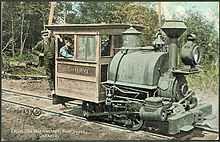Portage railway

An example of a small locomotive on a narrow gauge portage railway.
A portage railway is a short and possibly isolated section of railway used to bypass a section of unnavigable river or between two water bodies which are not directly connected.[1] Cargo from waterborne vessels is unloaded, loaded onto conventional railroad rolling stock, carried to the other end of the railway, where it is unloaded and loaded onto a second waterborne vessel. A portage railway is the opposite of a train ferry.
Examples
The following are or were locations of portage railways:
Australia
- Victor Harbor to Goolwa – originally horse drawn – mouth of Murray River often silted up or was useless due to low water levels.
- the first railway in Queensland started at the inland river port of Ipswich rather than the capital of Brisbane to save money. Twenty years later, the line was extended to Brisbane.
- several rail lines terminated at river ports, such as Robertson, Echuca, Bourke, Morgan, Brewarrina
Brazil
- Madeira-Mamoré Railroad (365 km; 227 mi) along the huge rapids of upper Madeira
Canada
- Champlain and St. Lawrence Railroad
- Chignecto Ship Railway
- Huntsville and Lake of Bays Transportation Company
- Nosbonsing & Nipissing Railway
- White Pass and Yukon Route
China
- The Three Gorges Portage Railways, on each side of the Yangtze River in the Three Gorges Dam area (see Three Gorges Dam#Portage railways). Preliminary work on this project started in 2012.[2]
Congo
- on Congo river:
- Matadi–Kinshasa Railway
- Congo-Ocean Railway
- Ubundu to Kisangani, see Great lakes line first section
England
- Cromford and High Peak Railway connected Cromford Canal to the Peak Forest Canal
Greece
- Diolkos near Corinth Canal
Laos
Panama
- Panama Railway
Russia
- Krasnoyarsk hydroelectric dam ship elevator [3][4]
United States
- Allegheny Portage Railroad
- Morris Canal
- New Castle and Frenchtown Turnpike and Rail Road
- Tuscumbia, Courtland and Decatur Railroad
References
- ↑ Derek Hayes (2006). "Historical Atlas of Canada: Canada's History Illustrated with Original Maps". Douglas & McIntyre. p. 210. ISBN 9781553650775. Retrieved 2013-03-23.
Most of Canada's first railways were portage railways, designed to meet river traffic and ferry it past rapids.
- ↑ 三峡翻坝铁路前期工作启动 建成实现水铁联运 (Preliminary work started on the Three Gorges Portage Railways. The project will implement a water-rail connection.) 2012-10-12 (Chinese) (The article includes a map)
- ↑ "Прохождение судами Енисейского пароходства судоподъемника Красноярской ГЭС - Фотогалерея". (Boats of the Yenisei Shipping Company traveling via the ship lift of the Krasnoyarsk Hydroelectric Station: Photo gallery) (Russian)
- ↑ From River to River - photo gallery, 2007